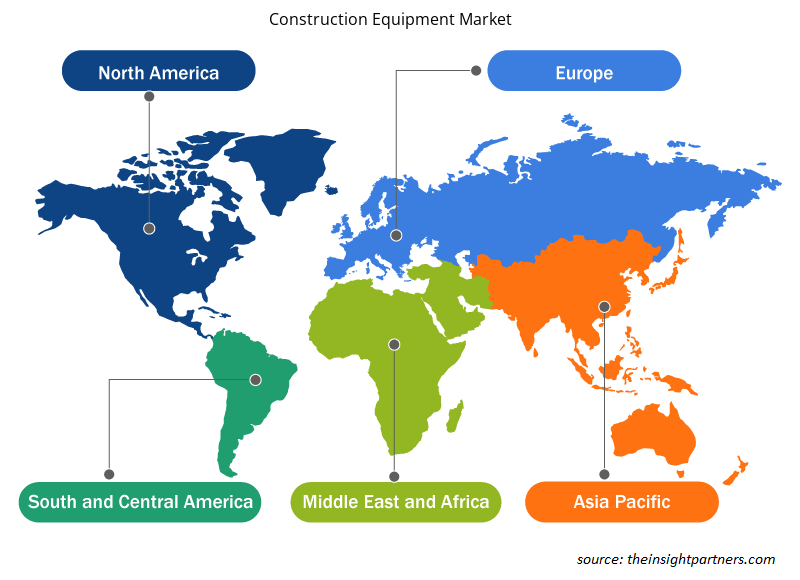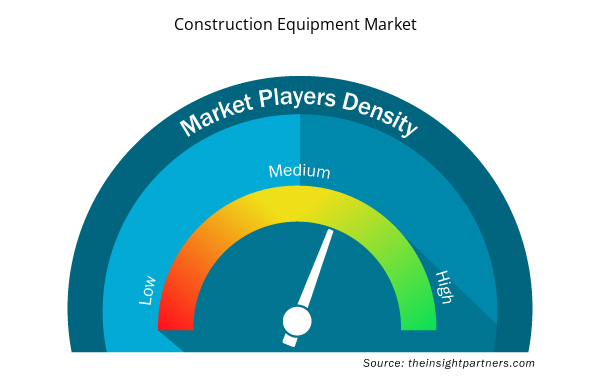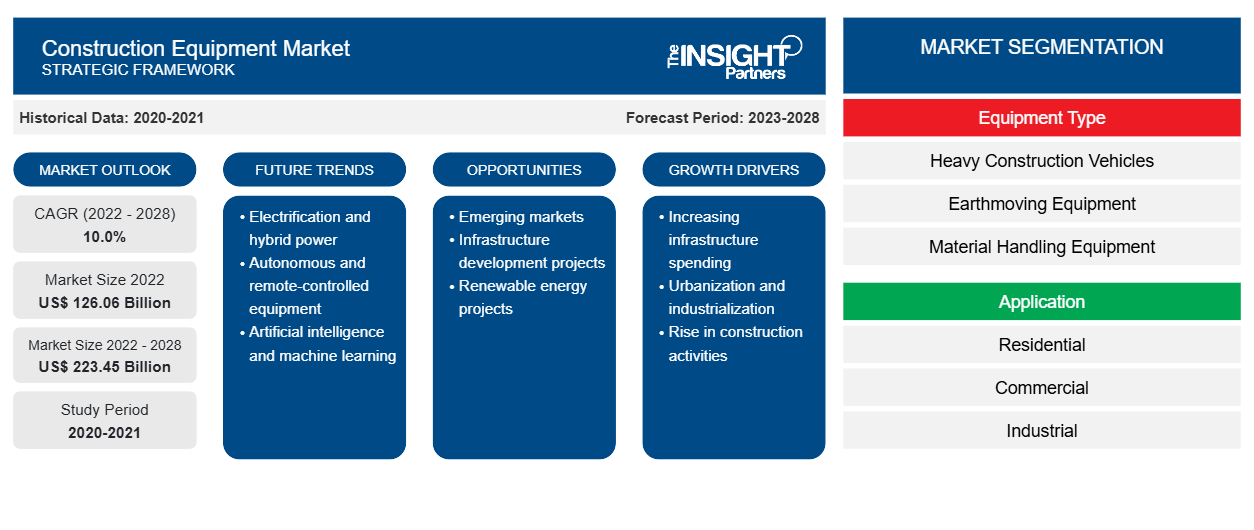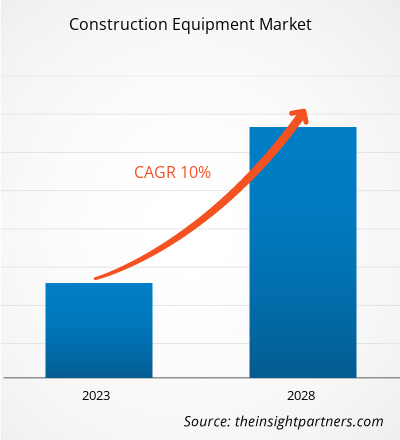Der Markt für Baumaschinen soll von 126.062,8 Millionen US-Dollar im Jahr 2022 auf 223.451,1 Millionen US-Dollar im Jahr 2028 wachsen; von 2022 bis 2028 wird mit einer durchschnittlichen jährlichen Wachstumsrate von 10,0 % gerechnet.
Als Baumaschinen werden Schwerlastfahrzeuge bezeichnet, die speziell für Bauarbeiten, meist Erdarbeiten, entwickelt wurden. Der richtige Einsatz geeigneter Geräte trägt zur Wirtschaftlichkeit, Qualität, Sicherheit, Geschwindigkeit und Termintreue des Projekts bei. Es ist nicht immer erwünscht oder machbar, dass der Auftragnehmer über alle für das Projekt benötigten Baumaschinen verfügt. Aushubarbeiten, Erdarbeiten, Erdbewegungen über große Entfernungen, Platzierung, Verdichtung, Einebnung, Planieren, Planieren und Transportieren gehören zu den wichtigsten Prozessen beim Bau eines Bauprojekts.
Verschiedene Aushubarbeiten, wie das Ausheben und Bewegen des Bodens, werden mit Erdbewegungsmaschinen ausgeführt. Erdbewegungsmaschinen sind in verschiedenen Formen und Größen erhältlich. Sie werden hauptsächlich für Reparatur-, Bau-, Hebe-, Landwirtschafts- und Abbrucharbeiten verwendet. Bagger sind Erdbewegungsmaschinen mit Schaufeln, Armen, drehbaren Kabinen und beweglichen Ketten. Ein Baggerlader, auch Heckbagger oder Heckbagger genannt, ist eine Art Aushubgerät mit einer Baggerschaufel, die am Ende eines zweiteiligen Gelenkarms befestigt ist. Ein Baggerlader ist eine Baumaschine, die Materialien wie Asphalt, Abbruchabfälle, Erde, Schnee, Futter, Kies, Baumstämme, Rohmineralien, Recyclingmaterial, Gestein, Sand und Holzspäne in oder auf eine andere Art von Maschine bewegt oder lädt.
Passen Sie diesen Bericht Ihren Anforderungen an
Sie erhalten kostenlose Anpassungen an jedem Bericht, einschließlich Teilen dieses Berichts oder einer Analyse auf Länderebene, eines Excel-Datenpakets sowie tolle Angebote und Rabatte für Start-ups und Universitäten.
- Holen Sie sich die wichtigsten Markttrends aus diesem Bericht.Dieses KOSTENLOSE Beispiel umfasst eine Datenanalyse von Markttrends bis hin zu Schätzungen und Prognosen.
Wichtige Akteure auf dem Baumaschinenmarkt sind Baumaschinenrohstoffe, Baumaschinenhersteller, die auf der Angebotsseite agieren, und Baumaschinenendnutzer, die auf der Nachfrageseite agieren. In den letzten Jahren ist die Nachfrage nach Baumaschinen insbesondere im Wohn- und Gewerbebau gestiegen, was das Wachstum des Baumaschinenmarktes in den nächsten fünf Jahren ankurbeln dürfte. Caterpillar, John Deere, Komatsu, Volvo und Liebherr gehören zu den wichtigsten Baumaschinenanbietern. Neben diesen großen Akteuren im Ökosystem gibt es mehrere andere periphere Akteure, die eine entscheidende Rolle bei der Ermöglichung technologischer Fortschritte und der Einführung dieser Produkte in mehreren Branchen spielen.
Auswirkungen der COVID-19-Pandemie auf den Baumaschinenmarkt
Im Jahr 2020 behinderte die COVID-19-Pandemie die Bautätigkeit. Infolgedessen gingen die Verkäufe von Baumaschinen weltweit zurück. Infrastrukturinvestitionen, Wohn-, Gewerbe- und Industriebau, Tief- und Brunnenbau sowie institutionelle Ausgaben wirken sich auf die Hersteller von Baumaschinen aus. Die USA, Großbritannien, China und Indien gehören zu den Ländern, die überproportional betroffen waren. Laut der International Construction Group verzögerte sich die Fertigstellung von über einem Viertel aller Projekte (22,7 %) um mehr als 250 Tage und mehr als ein Zehntel aller Projekte (13,4 %) um mehr als ein Jahr im Jahr. Projekte für Krankenhäuser und andere medizinische Einrichtungen, Labore sowie Schifffahrts- und Logistikinfrastruktur sind jedoch nur begrenzt verfügbar. Darüber hinaus haben mehrere Länder begonnen, die Aktivitäten verschiedener Branchen, einschließlich der Bauindustrie, schrittweise wieder aufzunehmen. Indien und China haben industrielle und gewerbliche Bauprojekte begonnen. Im April 2021 stieg die Industrieproduktion zum ersten Mal seit Januar 2021, als die Länder begannen, neue Projekte umzusetzen. Daher stieg die Nachfrage nach Baggern, Baggerladern, Verdichtern, Planierraupen und anderen Baumaschinen sprunghaft an.
Markteinblick
Steigende Infrastrukturinvestitionen nach der COVID-19-Pandemie
Aufgrund der COVID-19-Pandemie wurden die wirtschaftlichen Aktivitäten weltweit erheblich eingeschränkt. In den Jahren 2020–21 wurde enorm in die Infrastruktur investiert, was dem Wachstum der Infrastrukturbranche Auftrieb verlieh. Infrastrukturinvestitionen in die Stromerzeugung, den Bau nationaler Autobahnen, den Eisenbahnverkehr und den Frachttransport treiben die Nachfrage nach Baumaschinen an. In den Schwellenländern wiesen einige Kerninfrastrukturbranchen wie Kohle, Rohöl, Stahl und Zement im Jahr 2021 den Wachstumsindex auf. Diese Faktoren wirkten sich positiv auf das Wachstum des Baumaschinenmarktes aus. Infrastrukturinvestitionen haben langfristige Auswirkungen auf die Produktentwicklung, die das BIP langfristig steigern können, obwohl das Ausmaß dieser Auswirkungen unbekannt ist. Die meisten Länder, insbesondere im Nahen Osten, haben ein vierseitiges Wirtschaftsforum eingerichtet, um sich auf Infrastrukturentwicklungsprojekte in der Region zu konzentrieren. Um die Kommunikation zwischen Mitarbeitern und mit Verbrauchern zu erleichtern, nutzen Unternehmen digitale Lösungen und Kanäle. Regierungen und Bildungseinrichtungen haben dies ebenfalls getan.
Einblicke in das Segment der Gerätetypen
Aufgrund der steigenden Zahl von Gewerbe-, Wohn- und Industrieprojekten, für deren Erledigung schwere Werkzeuge und Maschinen erforderlich sind, wird heute mehr Baugerät verwendet als je zuvor. Bei großen Projekten wird schweres Baugerät für verschiedene Aufgaben eingesetzt. Die Wahl des Typs schweres Gerät richtet sich nach Umfang und Kosten des Projekts. Diese Faktoren erleichtern und beschleunigen den Bauprozess. Bagger sind ein wichtiges und häufig verwendetes Gerät im Bausektor.
Einblicke in Anwendungssegmente
Basierend auf der Anwendung ist der Markt für Baumaschinen in Wohn-, Gewerbe- und Industriebereiche unterteilt. Ein Bauwerkzeug, das als Asphaltmischanlage bekannt ist, wird verwendet, um beschichteten Straßenschotter und andere Arten von Asphaltbeton für den Einsatz in Straßenbauprojekten herzustellen. Straßenwalzen sind im Wesentlichen Verdichtermaschinen, die beim Bau von Straßen und Fundamenten Erde, Kies, Beton oder Asphalt nach unten drücken. Zum Installieren vorgefertigter Pfähle für Wolkenkratzer und andere riesige Industriekomplexe, die tiefe Fundamente benötigen, wird eine Pfahlbohrmaschine verwendet, um vertikale Löcher auf einer Baustelle zu bohren, was zum Wachstum des Marktes für Baumaschinen führt.
Die Akteure auf dem Markt für Baumaschinen konzentrieren sich auf neue Produktinnovationen und -entwicklungen, indem sie fortschrittliche Technologien und Funktionen integrieren, um mit der Konkurrenz zu konkurrieren. Im Juni 2022 gab Caterpillar Inc. bekannt, dass sein weltweiter Hauptsitz von Deerfield, Illinois, in die bestehende Anlage des Unternehmens in Irving, Texas, verlegt wird. Das Unternehmen wird 2022 mit der Verlegung seines Hauptsitzes nach Irving beginnen.
Basierend auf dem Gerätetyp ist der Markt für Baumaschinen in schwere Baufahrzeuge, Erdbewegungsmaschinen, Materialtransportmaschinen und andere unterteilt. Der Markt ist je nach Anwendung in Wohn-, Gewerbe- und Industriebereiche unterteilt. Nach Regionen ist der globale Markt für Baumaschinen in Nordamerika, Europa, Asien-Pazifik, Naher Osten und Afrika sowie Südamerika unterteilt.
Regionale Einblicke in den Baumaschinenmarkt
Die regionalen Trends und Faktoren, die den Baumaschinenmarkt im Prognosezeitraum beeinflussen, wurden von den Analysten von Insight Partners ausführlich erläutert. In diesem Abschnitt werden auch die Marktsegmente und die Geografie von Baumaschinen in Nordamerika, Europa, im asiatisch-pazifischen Raum, im Nahen Osten und Afrika sowie in Süd- und Mittelamerika erörtert.

- Erhalten Sie regionale Daten zum Baumaschinenmarkt
Umfang des Marktberichts für Baumaschinen
| Berichtsattribut | Details |
|---|---|
| Marktgröße im Jahr 2022 | 126,06 Milliarden US-Dollar |
| Marktgröße bis 2028 | 223,45 Milliarden US-Dollar |
| Globale CAGR (2022 - 2028) | 10,0 % |
| Historische Daten | 2020-2021 |
| Prognosezeitraum | 2023–2028 |
| Abgedeckte Segmente | Nach Gerätetyp
|
| Abgedeckte Regionen und Länder | Nordamerika
|
| Marktführer und wichtige Unternehmensprofile |
|
Dichte der Marktteilnehmer für Baumaschinen: Auswirkungen auf die Geschäftsdynamik verstehen
Der Markt für Baumaschinen wächst rasant, angetrieben durch die steigende Nachfrage der Endverbraucher aufgrund von Faktoren wie sich entwickelnden Verbraucherpräferenzen, technologischen Fortschritten und einem größeren Bewusstsein für die Vorteile des Produkts. Mit steigender Nachfrage erweitern Unternehmen ihr Angebot, entwickeln Innovationen, um die Bedürfnisse der Verbraucher zu erfüllen, und nutzen neue Trends, was das Marktwachstum weiter ankurbelt.
Die Marktteilnehmerdichte bezieht sich auf die Verteilung der Firmen oder Unternehmen, die in einem bestimmten Markt oder einer bestimmten Branche tätig sind. Sie gibt an, wie viele Wettbewerber (Marktteilnehmer) in einem bestimmten Marktraum im Verhältnis zu seiner Größe oder seinem gesamten Marktwert präsent sind.
Die wichtigsten auf dem Baumaschinenmarkt tätigen Unternehmen sind:
- Caterpillar Inc
- CNH Industrial NV
- Komatsu Ltd
- Liebherr
- Terex Corporation
Haftungsausschluss : Die oben aufgeführten Unternehmen sind nicht in einer bestimmten Reihenfolge aufgeführt.

- Überblick über die wichtigsten Akteure auf dem Baumaschinenmarkt
Baumaschinenmarkt – Firmenprofile
- Caterpillar Inc.
- CNH Industrial NV
- Hitachi Baumaschinen GmbH
- JC Bamford Excavators Ltd.
- Deere & Company
- Komatsu Ltd.
- Liebherr-International Deutschland GmbH
- Terex Corporation
- Volvo CE
- Zoomlion Schwerindustrie Wissenschaft und Technologie Co., Ltd.
- Historische Analyse (2 Jahre), Basisjahr, Prognose (7 Jahre) mit CAGR
- PEST- und SWOT-Analyse
- Marktgröße Wert/Volumen – Global, Regional, Land
- Branche und Wettbewerbsumfeld
- Excel-Datensatz


- Adaptive Traffic Control System Market
- Genetic Testing Services Market
- Hot Melt Adhesives Market
- Vision Care Market
- Excimer & Femtosecond Ophthalmic Lasers Market
- Ketogenic Diet Market
- Lyophilization Services for Biopharmaceuticals Market
- Artificial Intelligence in Healthcare Diagnosis Market
- Micro-Surgical Robot Market
- Vision Guided Robotics Software Market

Report Coverage
Revenue forecast, Company Analysis, Industry landscape, Growth factors, and Trends

Segment Covered
This text is related
to segments covered.

Regional Scope
North America, Europe, Asia Pacific, Middle East & Africa, South & Central America

Country Scope
This text is related
to country scope.
Häufig gestellte Fragen
Asia-Pacific dominated the Construction Equipment Market in 2021 with a share of 36.0%; it would continue to dominate the market during the forecast period and account for 38.4% share by 2028
The global construction equipment market size is projected to reach US$ 223451.09 million by 2028.
The material handling equipment segment led the construction equipment market in 2021.
APAC is the fastest-growing regional market in the global construction equipment market in 2021.
The key players holding the major market share of the construction equipment market are Caterpillar, Komatsu, VOLVO Construction Equipment, John Deere and Liebherr.
The Future trends impacting the construction equipment market are -- Growing Demand for the Artificial Intelligence
The global construction equipment market was valued at US$ 120661.95 million in 2021
The driving factors impacting the construction equipment market are
I. Increasing Infrastructure Investments Post COVID-19 Pandemic
Growing Focus on Public-Private Partnerships (PPP)
Trends and growth analysis reports related to Manufacturing and Construction : READ MORE..
The List of Companies -Construction Equipment Market
- Caterpillar Inc
- CNH Industrial N.V.
- Komatsu Ltd
- Liebherr
- Terex Corporation
- Zoomlion Heavy Industry Science&Technology Co., Ltd.
- J C Bamford Excavators Ltd. (JCB)
- Deere & Company
- AB Volvo
- Hitachi Construction Machinery Co., Ltd.
The Insight Partners performs research in 4 major stages: Data Collection & Secondary Research, Primary Research, Data Analysis and Data Triangulation & Final Review.
- Data Collection and Secondary Research:
As a market research and consulting firm operating from a decade, we have published and advised several client across the globe. First step for any study will start with an assessment of currently available data and insights from existing reports. Further, historical and current market information is collected from Investor Presentations, Annual Reports, SEC Filings, etc., and other information related to company’s performance and market positioning are gathered from Paid Databases (Factiva, Hoovers, and Reuters) and various other publications available in public domain.
Several associations trade associates, technical forums, institutes, societies and organization are accessed to gain technical as well as market related insights through their publications such as research papers, blogs and press releases related to the studies are referred to get cues about the market. Further, white papers, journals, magazines, and other news articles published in last 3 years are scrutinized and analyzed to understand the current market trends.
- Primary Research:
The primarily interview analysis comprise of data obtained from industry participants interview and answers to survey questions gathered by in-house primary team.
For primary research, interviews are conducted with industry experts/CEOs/Marketing Managers/VPs/Subject Matter Experts from both demand and supply side to get a 360-degree view of the market. The primary team conducts several interviews based on the complexity of the markets to understand the various market trends and dynamics which makes research more credible and precise.
A typical research interview fulfils the following functions:
- Provides first-hand information on the market size, market trends, growth trends, competitive landscape, and outlook
- Validates and strengthens in-house secondary research findings
- Develops the analysis team’s expertise and market understanding
Primary research involves email interactions and telephone interviews for each market, category, segment, and sub-segment across geographies. The participants who typically take part in such a process include, but are not limited to:
- Industry participants: VPs, business development managers, market intelligence managers and national sales managers
- Outside experts: Valuation experts, research analysts and key opinion leaders specializing in the electronics and semiconductor industry.
Below is the breakup of our primary respondents by company, designation, and region:

Once we receive the confirmation from primary research sources or primary respondents, we finalize the base year market estimation and forecast the data as per the macroeconomic and microeconomic factors assessed during data collection.
- Data Analysis:
Once data is validated through both secondary as well as primary respondents, we finalize the market estimations by hypothesis formulation and factor analysis at regional and country level.
- Macro-Economic Factor Analysis:
We analyse macroeconomic indicators such the gross domestic product (GDP), increase in the demand for goods and services across industries, technological advancement, regional economic growth, governmental policies, the influence of COVID-19, PEST analysis, and other aspects. This analysis aids in setting benchmarks for various nations/regions and approximating market splits. Additionally, the general trend of the aforementioned components aid in determining the market's development possibilities.
- Country Level Data:
Various factors that are especially aligned to the country are taken into account to determine the market size for a certain area and country, including the presence of vendors, such as headquarters and offices, the country's GDP, demand patterns, and industry growth. To comprehend the market dynamics for the nation, a number of growth variables, inhibitors, application areas, and current market trends are researched. The aforementioned elements aid in determining the country's overall market's growth potential.
- Company Profile:
The “Table of Contents” is formulated by listing and analyzing more than 25 - 30 companies operating in the market ecosystem across geographies. However, we profile only 10 companies as a standard practice in our syndicate reports. These 10 companies comprise leading, emerging, and regional players. Nonetheless, our analysis is not restricted to the 10 listed companies, we also analyze other companies present in the market to develop a holistic view and understand the prevailing trends. The “Company Profiles” section in the report covers key facts, business description, products & services, financial information, SWOT analysis, and key developments. The financial information presented is extracted from the annual reports and official documents of the publicly listed companies. Upon collecting the information for the sections of respective companies, we verify them via various primary sources and then compile the data in respective company profiles. The company level information helps us in deriving the base number as well as in forecasting the market size.
- Developing Base Number:
Aggregation of sales statistics (2020-2022) and macro-economic factor, and other secondary and primary research insights are utilized to arrive at base number and related market shares for 2022. The data gaps are identified in this step and relevant market data is analyzed, collected from paid primary interviews or databases. On finalizing the base year market size, forecasts are developed on the basis of macro-economic, industry and market growth factors and company level analysis.
- Data Triangulation and Final Review:
The market findings and base year market size calculations are validated from supply as well as demand side. Demand side validations are based on macro-economic factor analysis and benchmarks for respective regions and countries. In case of supply side validations, revenues of major companies are estimated (in case not available) based on industry benchmark, approximate number of employees, product portfolio, and primary interviews revenues are gathered. Further revenue from target product/service segment is assessed to avoid overshooting of market statistics. In case of heavy deviations between supply and demand side values, all thes steps are repeated to achieve synchronization.
We follow an iterative model, wherein we share our research findings with Subject Matter Experts (SME’s) and Key Opinion Leaders (KOLs) until consensus view of the market is not formulated – this model negates any drastic deviation in the opinions of experts. Only validated and universally acceptable research findings are quoted in our reports.
We have important check points that we use to validate our research findings – which we call – data triangulation, where we validate the information, we generate from secondary sources with primary interviews and then we re-validate with our internal data bases and Subject matter experts. This comprehensive model enables us to deliver high quality, reliable data in shortest possible time.


 Holen Sie sich ein kostenloses Muster für diesen Bericht
Holen Sie sich ein kostenloses Muster für diesen Bericht